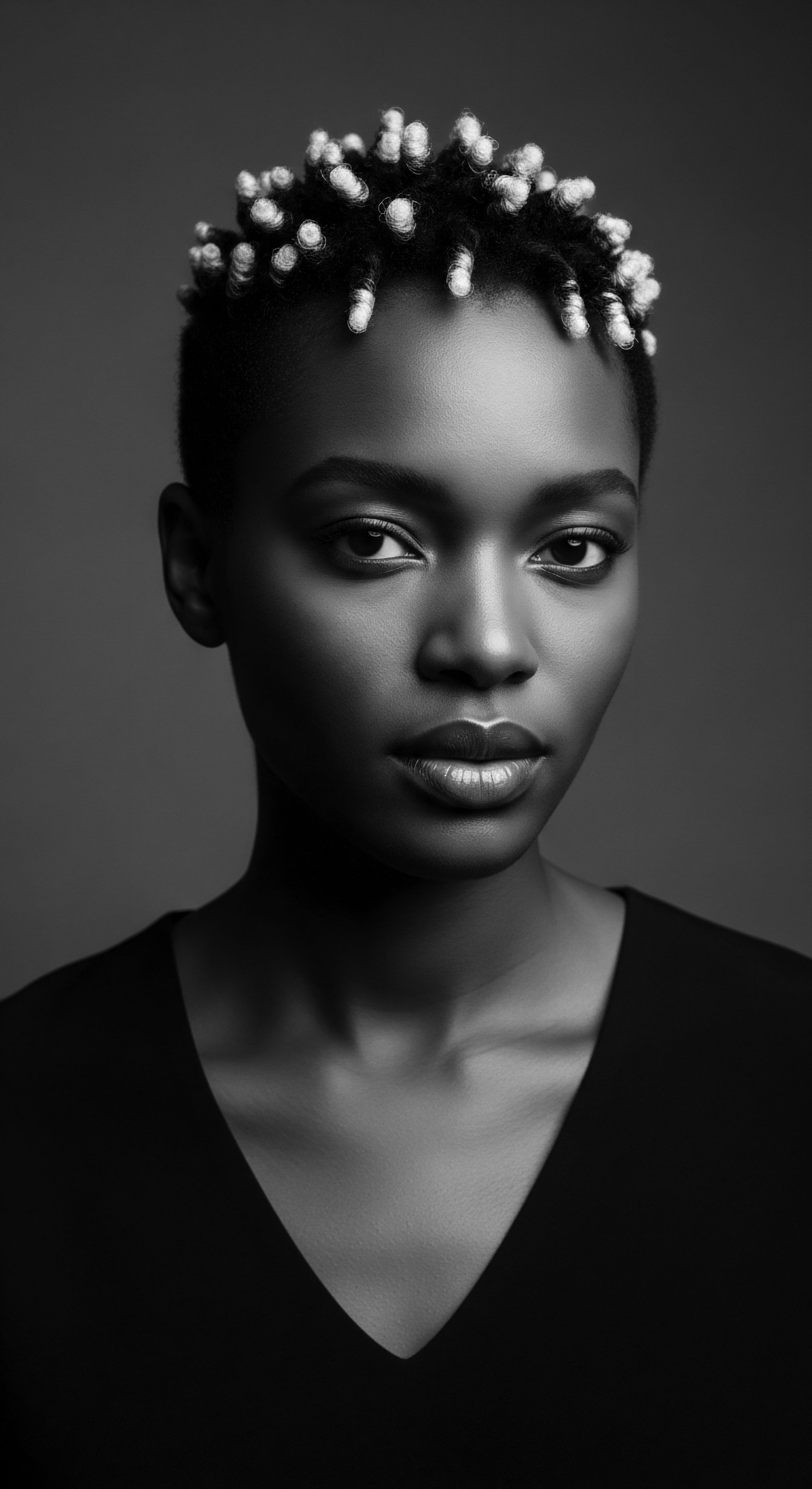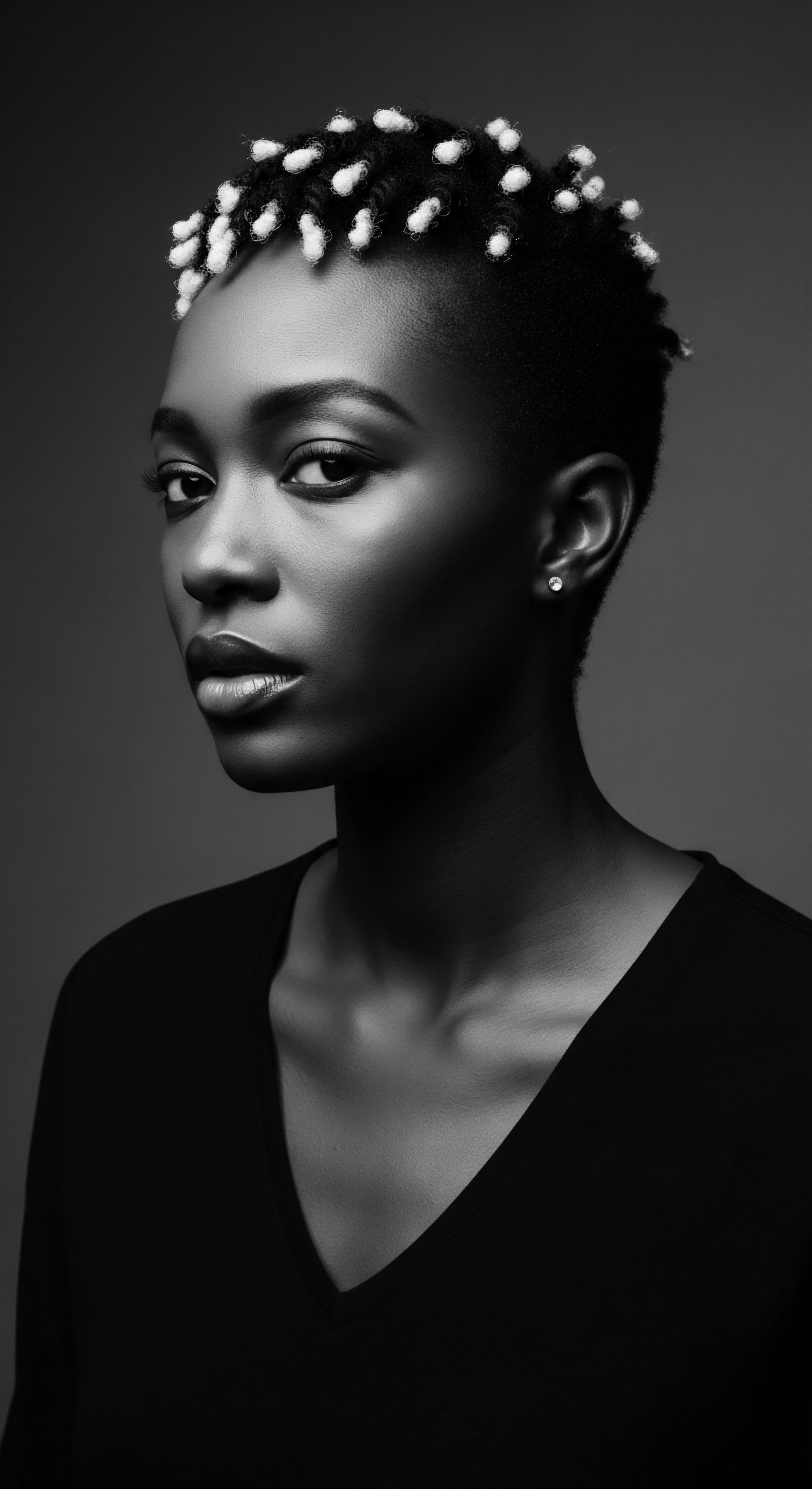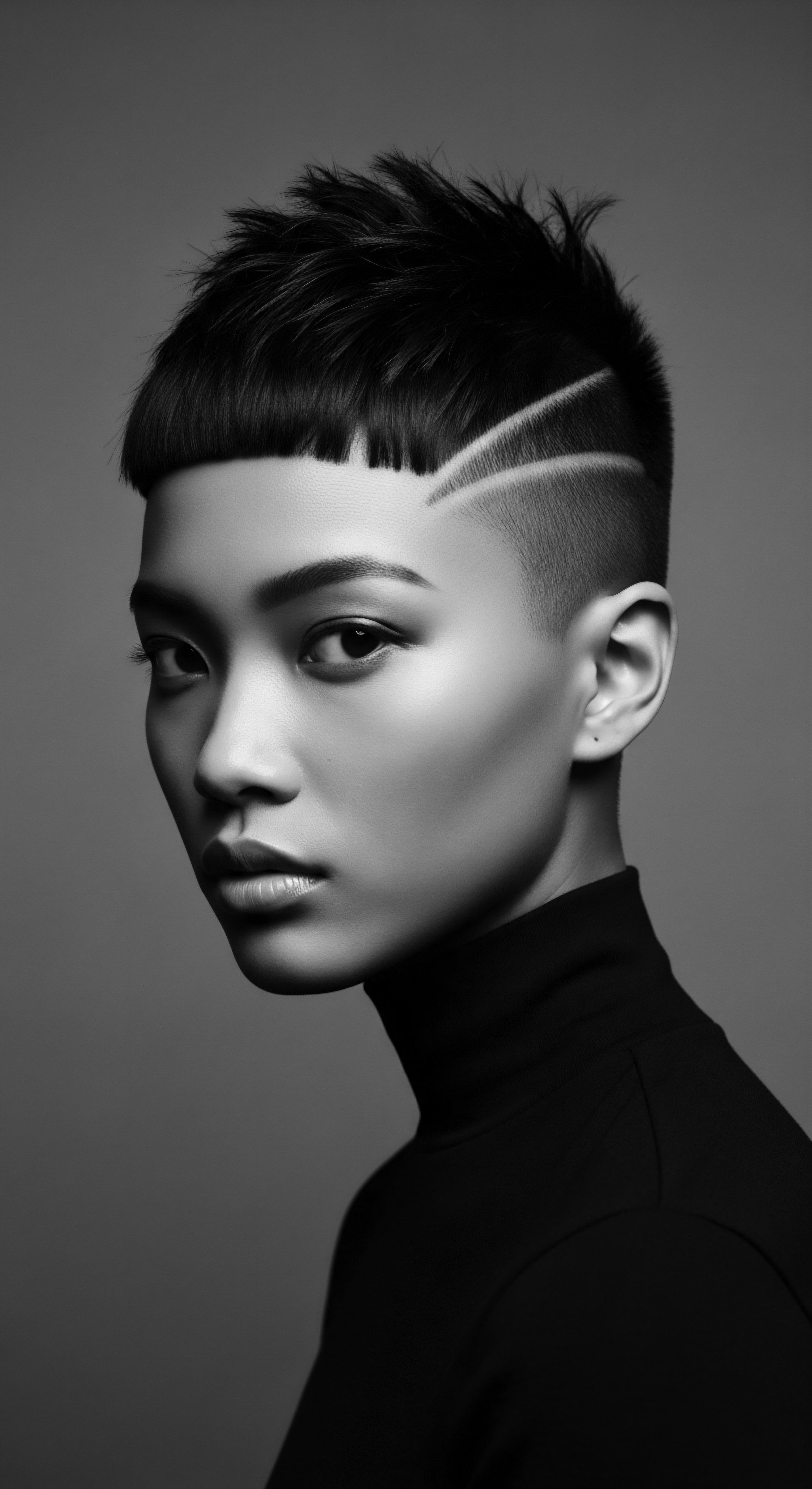
Roots
Consider, for a moment, the whisper of ancient hands upon a strand, the deliberate motion of a tool not merely grooming, but tending to a living crown. This is the origin point of our journey, tracing the deep connection between textured hair and the implements designed for its care. The very materials chosen for combs, from bone to wood to modern synthetics, carry a story within their form, shaping not only the physical well-being of the hair but also its cultural resonance across generations.
To truly grasp how material choices for combs influence textured hair, we must travel back, far before industrialization, to societies where hair was, and remains, a powerful communicator. In these early days, tools were born of the earth and ingenuity, their effectiveness a direct reflection of inherent properties. This exploration delves into the elemental relationship between a hair strand and the surface it encounters, viewed through the profound lens of ancestral practices and their lingering wisdom.

Hair Anatomy and Its Ancestral Connection
Textured hair, with its unique helical structure, presents a distinct set of considerations when groomed. Unlike straight strands, which offer fewer points of contact and friction, coils and curls possess natural bends and turns. These undulations mean the hair is inherently predisposed to intertwine and form groups, requiring a gentle approach to manipulation.
From a biological standpoint, the cuticle layers of textured hair, while structurally similar to other hair types, are more exposed at the curves of the strand, making them susceptible to lift and damage from harsh mechanical action. The integrity of these cuticle scales, responsible for smoothness and protection, relies heavily on the interaction with grooming tools.
The choice of comb material for textured hair is a conversation between ancestral wisdom and the inherent biology of the strand.
Historically, this understanding, though not articulated in scientific terms, was deeply ingrained in traditional hair practices. Communities recognized the hair’s tendency to resist simple passage, learning to work with its natural inclinations rather than against them. This sensitivity gave rise to tools designed to honor the hair’s structure, not force it into submission.
The connection was holistic ❉ caring for hair equaled caring for self, for community, for lineage. It was a tangible link to identity, passed down through the gentle rhythm of a mother detangling her child’s curls with a hand-carved piece of wood, each stroke a silent lesson in reverence and preservation.

Early Comb Materials and Their Cultural Meanings
For millennia, combs were crafted from natural resources available within specific environments, reflecting a deep respect for and reliance upon the earth. These early materials offered properties that naturally suited the needs of textured hair, often without conscious scientific analysis, but through generations of trial and practiced application. Archaeological evidence from ancient civilizations in Africa, particularly Kush and Kemet (modern-day Sudan and Egypt), reveals wooden, bone, and ivory combs dating back over 5,500 years. These implements were not merely functional; they held immense cultural and spiritual weight, sometimes buried with their owners, affirming hair’s sacred standing.
- Wood ❉ Often sourced from hardwoods, these combs were frequently hand-carved and polished. The smooth, porous nature of wood allows it to absorb natural oils from the hair and redistribute them, contributing to lubrication during detangling. Its natural warmth and pliability make it less prone to creating static electricity, a common concern for textured hair which can lead to frizz and breakage. The specific type of wood could hold regional or spiritual significance. In Ghana, for instance, the Dua’afe (wooden comb) is linked to femininity and beauty.
- Bone ❉ Animal bone and ivory (from various animals, not solely elephants) offered durability and a smooth surface. These materials were shaped and refined, sometimes bearing intricate carvings that communicated tribal identity, social standing, or protective symbols. The inherent density of bone provided strength for navigating dense curl patterns while its smooth finish reduced friction.
- Horn ❉ Derived from animal horns, this material possessed a natural smoothness and a degree of flexibility. Horn combs could be shaped and polished to create gentle teeth, offering another viable option for minimizing snags and breakage. Like bone, horn was a testament to resourcefulness, making use of all aspects of an animal.
The earliest known comb discovered, unearthed from a tomb in ancient Kemet, is over 6,000 years old, fashioned from wood and animal bones. These tools were adorned with inscriptions, frequently representing nature, such as birds, bull horns, or hippopotamuses, underscoring a deep connection to the environment. This historical context reveals that the relationship between combs and textured hair began as a dialogue with the natural world, a conversation in which the choice of material was not arbitrary, but deeply purposeful and culturally resonant.

A Question of Ancient Innovation
How did ancestral wisdom guide the selection of materials for combs, long before modern scientific understanding?
Ancestral wisdom, honed over countless generations, relied on observation, tactile experience, and an intuitive comprehension of natural properties. The efficacy of a material for hair care was not dictated by chemical analysis but by direct interaction ❉ did it glide through the hair with minimal resistance? Did it cause pain or discomfort? Did it preserve the hair’s integrity?
The materials that proved gentle, durable, and effective for detangling and styling dense, coily hair became cornerstones of hair care traditions. This cumulative knowledge was then passed down, not as written decrees, but as lived practices, embodied within the act of care itself. For example, the recognition that wood or bone, when smoothed, could navigate tightly coiled strands better than rougher alternatives was a practical truth, a lived experience that reinforced their continued use. The cultural value assigned to these materials reinforced their presence in grooming rituals, elevating them beyond mere utility.

Ritual
The journey of a comb through textured hair is seldom just a mechanical process; it is a ritual, a connection to a legacy of care that spans generations. The choice of comb material becomes a silent participant in this ritual, influencing the ease of passage, the health of the hair, and the very feeling of the experience. From the broad-toothed wooden picks of ancient Africa to the contemporary plastic wide-tooth combs, the physical attributes of these tools – their smoothness, tooth spacing, and charge – directly alter their interaction with textured strands.
Understanding these interactions requires moving beyond simple observation to consider the microscopic world of the hair shaft. Each material has a distinct surface topography and electrical property, both of which play a determinant role in how a comb navigates the unique architecture of coiled and curly hair. This section explores how material choices shape the everyday rituals of detangling and styling, influencing hair health and preserving historical customs.

The Interplay of Material and Hair Surface
The surface of a comb, on a microscopic scale, is rarely perfectly smooth. Even what appears polished to the naked eye can possess minute imperfections, edges, or pores. Textured hair, with its characteristic curl pattern and varied cuticle scales, is particularly sensitive to these surface characteristics. When a comb’s tooth passes through a coil, the hair strand is pulled along its surface.
Any irregularities on the comb, such as mold seams on plastic or splintered edges on poorly finished wood, can snag and lift the hair’s outer cuticle layer. This lifting leads to increased friction, potential breakage, and a rougher hair surface, which in turn causes more tangling. Conversely, a highly polished, uniformly smooth surface allows the hair to glide with minimal resistance, preserving cuticle integrity.
Plastic combs, while widely accessible, often present a particular challenge. Their manufacturing process can leave behind microscopic seams or uneven edges between the teeth, leading to increased friction and potential hair damage. Furthermore, plastic is an insulating material, prone to generating static electricity, particularly in dry environments. This static charge causes individual hair strands to repel each other, leading to frizz and making detangling more challenging.
Wooden combs, especially those made from fine-grained hardwoods and well-finished, tend to have smoother surfaces and are less likely to produce static. Their natural porosity may also contribute to a gentler passage, as some hair oils can be absorbed into the wood, acting as a natural lubricant. Bone or horn combs, when expertly polished, share a similar advantage of reduced static and smooth interaction, drawing from their organic composition.
| Material Wood (e.g. mahogany, olive wood) |
| Historical Context / Source Ancient African cultures, traditional craft. |
| Interaction with Textured Hair Naturally smooth, reduces static, can absorb and redistribute oils. Gentler on cuticle, less snagging. |
| Contemporary Relevance for Heritage Care Preferred for low friction detangling, supports ancestral wellness philosophy. |
| Material Bone/Ivory (animal sources) |
| Historical Context / Source Ancient Kemet, Kush, royal adornments. |
| Interaction with Textured Hair Very smooth when polished, minimal static. Durable for dense hair. |
| Contemporary Relevance for Heritage Care High quality bone combs offer similar benefits to wood, connecting to ancient practices. |
| Material Horn (animal sources) |
| Historical Context / Source Medieval Europe, also used in antiquity. |
| Interaction with Textured Hair Offers a natural, smooth glide; similar properties to bone with reduced static. |
| Contemporary Relevance for Heritage Care Valued for its gentle qualities and connection to natural materials. |
| Material Plastic (various types) |
| Historical Context / Source Modern mass production (post-20th century). |
| Interaction with Textured Hair Prone to mold seams and static charge. Can increase friction and breakage. |
| Contemporary Relevance for Heritage Care Accessibility and affordability are factors, but careful selection for smoothness is vital. |
| Material Metal (e.g. brass, steel) |
| Historical Context / Source Some historical use for heated tools, modern picks. |
| Interaction with Textured Hair Can be harsh if teeth are sharp, high potential for static and heat conduction. |
| Contemporary Relevance for Heritage Care Specific use in hot combs (historical context) or durable Afro picks, but requires careful handling. |
| Material The journey from natural elements to synthetic ones demonstrates a shift in priorities, from inherent material compatibility to mass production. |

Adapting Tools to Textured Hair Forms
The morphology of textured hair, from loose waves to tight coils, shapes the requirements for a suitable comb. Wider tooth spacing and smooth, rounded tips are almost universally gentler on textured hair, allowing coils to pass through without being stretched taut or fractured. This understanding is reflected in the historical evolution of combs designed for African hair. The Afro Comb, for example, a tool whose origins date back at least 5,500 years in Africa, features widely spaced, long teeth, perfectly suited for lifting, detangling, and shaping voluminous hair.
The shift in comb materials over time, from naturally occurring resources to mass-produced synthetics, holds cultural significance. While early combs were a testament to available resources and craft, the rise of plastic in the 20th century democratized access but introduced new challenges. Cheaper plastic combs, often with sharp edges and static-generating properties, could work against the natural inclinations of textured hair, leading to increased breakage and discomfort. This period coincided with societal pressures to straighten or alter textured hair, making the choice of styling tool even more complex within the broader context of beauty standards and acceptance.
Yet, even during times of adversity, traditions persisted. During the transatlantic slave trade, when access to traditional tools was severely limited, enslaved Africans ingeniously crafted combs from whatever scraps were available, be it wood, metal, or animal bones, preserving essential grooming practices and connecting to their heritage.
The comb is not a neutral instrument; its material form reflects epochs of cultural practice and scientific insight regarding hair care.
The enduring presence of the wide-tooth comb and the Afro pick within textured hair care is a direct lineage to these ancestral tools, a silent acknowledgment of what works best with the hair’s natural inclinations. While modern innovations offer new possibilities, the wisdom embedded in choosing materials that respect the hair’s structure continues to be a guiding principle, a testament to inherited knowledge. The resistance to external standards that once demonized textured hair is expressed, in part, by the persistent preference for tools that celebrate its inherent form.

Relay
The question of comb materials and their impact on textured hair extends far beyond simple mechanics; it resonates with the deep echoes of heritage, societal expectations, and the enduring spirit of resilience. To understand this layer of influence requires an examination of the historical interplay between hair tools, the science of hair behavior, and the cultural movements that have shaped perceptions of Black and mixed-race hair. The material composition of a comb can either honor or disrupt the intricate balance of the hair strand, a balance often intrinsically linked to ancestral practices and identity. This section ventures into the more complex, interconnected dimensions of material choice, bridging ancient wisdom with contemporary scientific insights and their cultural implications.

The Subtleties of Surface Energy and Hair Health
Beyond macroscopic smoothness, the surface energy of a comb’s material influences its interaction with hair. Hair, particularly textured hair with its numerous cuticle edges, carries a surface charge. Different materials, when rubbed against hair, can induce varying levels of static electricity due to electron transfer. Materials with a propensity to gain or lose electrons, such as certain plastics, create a greater electrostatic charge, causing hair strands to repel each other.
This electrostatic repulsion leads to visible frizz, makes detangling more challenging, and can contribute to breakage as individual strands are pulled apart by opposing charges rather than sliding freely. The accumulation of static can also disrupt the cuticle layer, leaving hair more vulnerable to environmental stressors and moisture loss.
Natural materials such as wood, bone, and horn generally possess lower surface energy and are less prone to generating static. This makes them inherently gentler on textured hair. Their organic composition tends to be more harmonious with the hair’s own protein structure, leading to reduced friction and a smoother passage through coils.
The natural oils present in wood can also help to condition the hair over time, a subtle but beneficial effect that reflects a more symbiotic relationship between tool and hair. This scientific understanding validates the preferences for natural combs observed in many ancestral hair traditions, where the absence of static and the gentle feel were likely experienced as a tangible benefit, even without the language of physics.
Consider the specific historical example of the Akan people of Ghana and their traditional combs. Among the Akan, combs were not only practical grooming items but also meaningful gifts, frequently exchanged as declarations of love or marriage tokens, often bearing depictions of feminine beauty or fertility. These combs, typically carved from wood, exemplify a tool where material selection aligned with both functional efficacy and profound cultural significance.
The choice of wood, likely due to its smooth glide and absence of static, supported hair health in a climate often characterized by humidity, while its aesthetic appeal and symbolic carvings connected the act of hair care to community, status, and spirituality. This cultural practice, therefore, unconsciously integrated a material science that was optimal for textured hair, revealing a deeper, inherent knowledge of what benefited the hair structure.

Comb Design and the Preservation of Hair Morphology
The architecture of a comb, particularly the spacing and taper of its teeth, is as vital as its material in navigating textured hair. Modern hair science affirms what ancestral practices demonstrated ❉ wide-set, rounded teeth are superior for detangling coiled and curly hair. This design minimizes the stretching and pulling of individual curls, preserving their natural helical shape and reducing tension on the hair follicle. Narrow-toothed combs, common for straight hair, can shred the delicate curl patterns of textured hair, leading to breakage and irreversible damage to the strand’s integrity.
The historical Afro pick, with its distinct wide-tooth configuration, emerged as a response to the specific needs of coily hair, allowing for volume without disturbing curl definition. While its popularization in the 1960s and 70s was deeply tied to the Black Power movement – becoming a potent symbol of identity, self-acceptance, and resistance – its functional design principle was rooted in millennia of practical application. This particular design, often made of plastic during its modern resurgence, still adheres to the core principle of wide-tooth spacing.
This highlights a convergence ❉ modern scientific understanding now explains why certain traditional designs work effectively for textured hair, reinforcing the validity of inherited practices. The physical design, supported by appropriate material choice, becomes a conduit for care that echoes past traditions and empowers current self-expression.
Ancestral choices of natural materials for combs mirror modern scientific findings on optimal hair care tool properties.
The connection between comb material and hair health becomes even more pronounced when considering the long-term impact on hair growth and retention. Consistent use of combs that snag, create static, or cause friction contributes to incremental damage, leading to thinning, split ends, and difficulty retaining length. For hair that historically faced stigmatization and systemic efforts to suppress its natural form, the choice of a comb that respects its inherent structure becomes an act of self-preservation and a reclamation of heritage.
It speaks to a conscious decision to nurture, rather than battle, one’s natural hair, aligning with the philosophy of holistic wellness that centers ancestral wisdom. The material of the comb, therefore, carries weight far beyond its physical presence; it holds the potential to sustain or diminish the vitality of hair that holds generations of stories.
- Thermal Conductivity and Heat Retention ❉ Different materials conduct and retain heat at varying rates. Metal combs, historically used as hot combs, readily absorb and transfer heat, enabling temporary straightening. However, this high thermal conductivity can lead to direct heat damage if not precisely controlled, a challenge often faced with traditional stove-heated metal combs. Wood, bone, or plastic, on the other hand, have lower thermal conductivity, making them less suitable for heat styling but safer for daily cold detangling.
- Hygroscopic Properties ❉ Certain materials, particularly wood, are hygroscopic, meaning they can absorb and release moisture. This property might allow wooden combs to interact with the hair’s moisture content in a subtle way, potentially helping to balance hydration during grooming. This contrasts with non-porous plastics, which do not interact with moisture in the same manner.
- Durability and Maintenance ❉ The robustness of a comb’s material influences its lifespan and efficacy. While a well-crafted wooden comb can last for decades with proper care, plastic combs are prone to breakage and wear, often developing sharp edges over time that can harm hair. The longevity of traditional tools speaks to a sustainable approach to resources, where tools were made to endure, reflecting a philosophy of mindful consumption that extends to hair care.

Reflection
The humble comb, in its myriad forms and materials, stands as a quiet yet powerful testament to the enduring story of textured hair. Our exploration reveals that the choice of material—be it the grounding presence of ancient wood, the refined strength of bone, or the practical utility of modern plastic—is never a neutral decision. Each material carries echoes of human ingenuity, cultural values, and a deep, often subconscious, understanding of hair’s intrinsic needs. From the archaeological finds in Kush and Kemet, demonstrating tools carved with symbols of identity and status, to the resilience of enslaved Africans crafting rudimentary combs, and the assertive embrace of the Afro pick during the Civil Rights movement, the comb’s journey is interwoven with the very fabric of Black and mixed-race heritage.
In every stroke, the comb either honors or challenges the natural architecture of textured strands. A finely polished wooden tooth, for instance, minimizes friction and static, respecting the hair’s delicate cuticle. A poorly manufactured plastic comb, conversely, can snag and cause breakage, creating a dissonance between tool and hair. This recognition is not merely scientific; it is a profound affirmation of ancestral wisdom, a validation of practices honed over generations that inherently understood the needs of coiled and curly hair.
The pursuit of “good” hair, historically dictated by oppressive standards, often led to damaging practices and unsuitable tools. Today, a return to natural textures and the intentional selection of combs that support hair health serve as acts of reclamation, a conscious return to self and lineage.
This enduring conversation between hand, tool, and hair speaks to more than aesthetics; it speaks to survival, to defiance, and to the continuous creation of beauty against all odds. The legacy held within each strand of textured hair, nurtured by the right tools and respectful practices, remains a living archive, a constant source of strength and cultural pride. This is the Soul of a Strand, ever unfolding, ever true.

References
- Ashton, S. (2013). 6,000 Years of African Combs. Cambridge ❉ The Fitzwilliam Museum.
- Byrd, A. D. & Tharps, L. L. (2001). Hair Story ❉ Untangling the Roots of Black Hair in America. St. Martin’s Press.
- Chimbiri, K. N. (2013). Secrets of the Afro Comb ❉ 6,000 Years of Art and Culture. Golden Destiny Limited.
- Dabiri, E. (2019). Twisted ❉ The Tangled History of Black Hair Culture. Dey Street Books.
- Flowers, E. (2018). Hot Comb. Drawn and Quarterly.
- Rosado, S. (2003). The Grammar of Hair ❉ Understanding African-American Women’s Hair Narratives. Dissertation.
- Tate, S. (2007). Black Beauty ❉ African American Women and the Politics of Race. Bloomsbury Academic.
